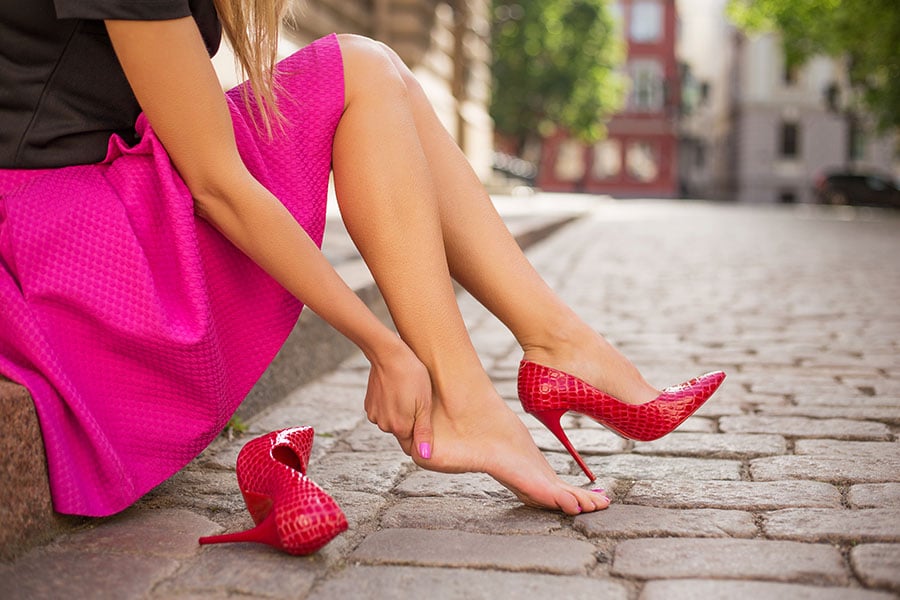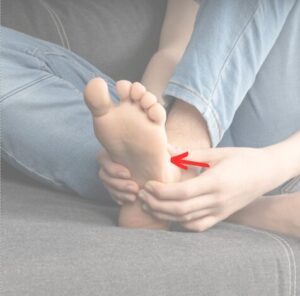What is Heel Pain?
The heel bone also known as the calcaneum in Latin is the largest bone in the foot, designed to shock absorb and redirect forces required in bipedal (two-legged) motion, springboarding us forwards and cushioning the next step we take.
As chiropodists | podiatrists it is important that we distinguish between a patient presenting with a vascular, autoimmune, infectious or neoplastic heel pain origin. The heel bone’s length is longer than its height and width, like a rectangle with rounded edges. It has many soft tissue attachments, a rich nerve and blood supply with strategic bursae. In certain presentations, these bursae can become inflamed and exacerbate a heel pain presentation.
Why is my heel painful?
A tendon known as the posterior tibial tendon is a very important muscle and tendon. It attaches extensively to the underside of the foot. Here we usually observe a flattening of the arch due to a dysfunctional tendon that has fatigued. It can be due to biomechanical factors, often mistaken for simple heel pain.
Located at the underside of the heel is fatty padding made up of dense pockets of fat surrounded and interwoven with stretchy muscle fibres found under the heel bone to protect and cushion. However, as we age this fatty padding can shrink to half its original size. So its elasticity is reduced and the ability to cushion is effectively reduced. This presentation is also known as fat pad atrophy and is another cause of heel pain.
One of the most common things we hear from patients is: ‘I have been told I have plantar fasciitis’ or the precise term plantar fasciopathy. This is because the plantar fascia is considered the keystone of the foot. Also, it comprises numerous slips of fascia that actually attach all the way up into the underside of the toes. If damaged, it can become very disabling, taking months to repair and recover. Are you suffering from painful heels at night?
Your heel may become tender or swollen from:
- Shoes with poor support or shock absorption
- Sudden inward or outward turning of your heel
- Running on hard surfaces, like concrete
- Running too often
- Landing hard or awkwardly on the heel
- Tightness in your Achilles tendon or calf muscle
What Causes Heel Pain?
Overuse, such as long periods of standing, microtrauma such as repeating and heavy loading, or the presence of heel spurs can sometimes complicate and lengthen symptomatic periods, especially if nerves (tarsal tunnel syndrome and/or medial calcaneal neuritis) are impinged within the plantar fascia, suggesting what is known as a recalcitrant heel pain a.k.a. very stubborn!
In cases of extreme sports, excessive jumping, heel hurts after running or excessive force although fortunately rare, observe fractured heel bones. In which it will need total immobilisation and zero weight-bearing for a period of time.
Thus, check your footwear – a supportive shoe or trainer with a deep heel cup is ideal. If possible try to avoid standing on your feet for long periods of time. Also, avoid walking barefoot if you can. Physical therapy is often a good companion to any treatment plan. Stretching exercises can help build endurance and reduce pain during everyday motion, and help build yourself up for further exercise.
Can being overweight cause heel pain?
Obesity and being overweight can cause plantar fasciitis. The added pressure of extra pounds can cause flat feet, placing extra strain on the plantar fascia that makes walking or standing extremely painful.
Paola Ash osteos MSK | podiatrists MChS & associates
Are you suffering from this condition? One of our podiatrist can assist and then recommend what treatment options are best to get you back on track. ✅
Schedule an appointment here or you may call us at 44 (0) 207 101 4000. 📞
We hope you have a feetastic day! 👣☀️
-The Chelsea Clinic and Team




